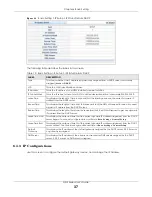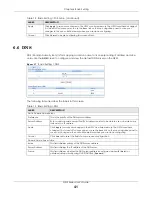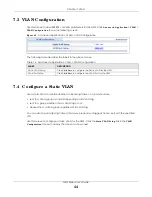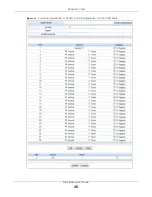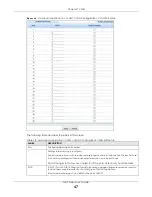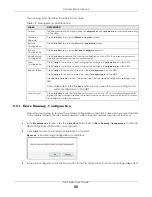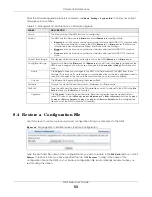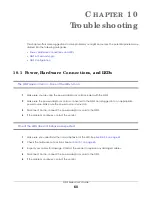
Chapter 8 Maintenance
NSW Series User’s Guide
50
The following table describes the labels in this screen.
8.2.1 Era se Running - C o nfig ura tio n
Follow the steps below to remove the running configuration on the NSW. Unlike when you reset the NSW
to the factory defaults, the username, password, system logs and memory logs are not removed.
1
In the
Ma inte na nc e
screen, click the
C lic k He re
button next to
Era se Running - C o nfig ura tio n
to clear all
NSW configuration information you configured.
2
Click
O K
to remove the running configuration on the NSW.
Fig ure 44
Erase Running-Configuration: Confirmation
3
In the web configurator, click the Save button in the top of the screen to make the changes take effect.
Table 19 Management > Maintenance
LABEL
DESC RIPTIO N
Current
This field displays which configuration (
C o nfig ura tio n 1
or
C o nfig ura tio n 2
) is currently operating
on the NSW.
Firmware
Upgrade
Click
C lic k He re
to go to the
Firm wa re Upg ra de
screen.
Restore
Configuration
Click
C lic k He re
to go to the
Re sto re C o nfig ura tio n
screen.
Backup
Configuration
Click
C lic k He re
to go to the
Ba c kup C o nfig ura tio n
screen.
Erase Running-
Configuration
Click
C lic k He re
to remove the running configuration on the NSW. The username, password,
system logs and memory logs are not removed.
Save
Configuration
Click
C o nfig 1
to save the current configuration settings to
C o nfig ura tio n 1
on the NSW.
Click
C o nfig 2
to save the current configuration settings to
C o nfig ura tio n 2
on the NSW.
Reboot System
Click
C o nfig 1
to reboot the system and load
C o nfig ura tio n 1
on the NSW.
Click
C o nfig 2
to reboot the system and load
C o nfig ura tio n 2
on the NSW.
Click
Fa c to ry De fa ult
to reboot the system and load the default configuration settings on the
NSW.
Note: Make sure to click the
Sa ve
button in any screen to save your settings to the
current configuration on the NSW.
Tech-Support
Click
C lic k He re
to see the Tech-Support screen. You can set CPU and memory thresholds for
log reports and download related log reports for issue analysis. Log reports include CPU history
and utilization, crash and memory.


